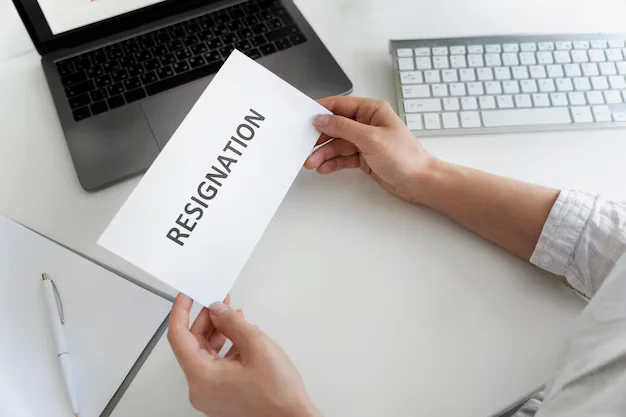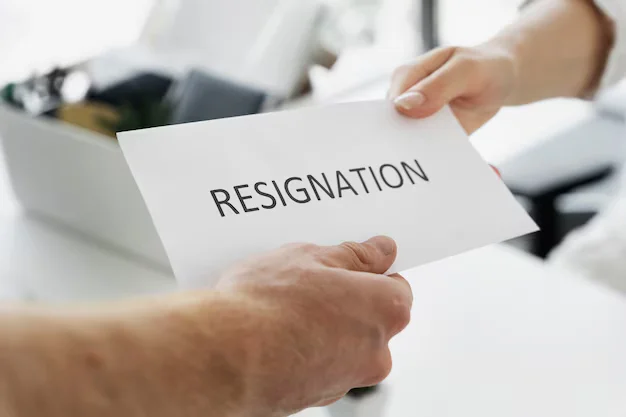How To Write A Resignation Letter If You’re Working Remote Or Work From Home
If you work remotely and want to prepare a resignation letter for your employer, this blog post is the perfect place to start. Of course, a resignation letter should always be polite and professional, even if you’re leaving on bad terms with your company.
There are numerous reasons for leaving a job. You wish to look into more options for improved professional paths or a career move. Perhaps you need to resign because you dislike the business culture or your employment is incompatible with your responsibilities at home.
Whatever your reasons, learning how to gracefully and positively resign from your current work is critical. While this is simpler to achieve when you work in an office, it is not the same when you work remotely.

Learn how to write a resignation letter if you're working remote, covering the entire process of submitting a resignation letter via email.
This article will take you through the steps of writing and preparing a resignation letter while working in a remote setup.
What is a Resignation Letter?
A resignation letter is a formal document through which an employee informs their employer of their intention to quit their job.
This letter acts as the official confirmation of the employee's plan to terminate their employment and generally states the effective date of resignation, often providing a minimum of two weeks' notice in line with standard professional practices.
Additionally, the letter can be a means for the employee to express thanks for the opportunities and experiences gained during their time at the company, discuss their reasons for leaving, and offer to help with the transition process. This might include training a successor or wrapping up current projects.
It is essential to recognize that the resignation letter forms part of a broader resignation procedure that could also entail a direct discussion with a supervisor or an exit interview.
Serving as a formal record of resignation, this letter aids in preserving a good professional relationship with the employer, which can be advantageous for obtaining references and for future networking opportunities.
Draft Your Resignation Letter

A resignation letter is much the same regardless of whether you're working remotely or on-site.
Begin your resignation letter with a formal subject line, such as “To Whom It May Concern” in your company name, setting a professional manner for your departure. After that, give a short description of your employment history and why you are leaving.
This part is essential for your future employer and your current role supervisors to understand the nature of your resignation, especially if you are considering a counter offer or facing a challenging work environment.
As with any type of writing, it’s necessary to be clear and concise when drafting your letter. Make sure that you don't ramble on for too long about various topics or feel the need to repeat yourself to make a point.
A resignation letter is a formal document that informs your employer of your departure. Even if you're leaving because of your boss, make sure to remain professional and never go out of line. Before ending your letter, assure that you will assist with all necessary processes and procedures.
Lastly, don't forget to provide your contact details and schedule a video meeting or Zoom meeting for any exit interviews or discussions about the two weeks' notice period.
It is also essential to obtain a copy of your pay stub from your company to settle any probable deficiencies or issues. You can also generate your own financial documents from online platforms such as Paystubsnow.
Tips for writing a resignation letter

It is critical to have your resignation letter ready before the initial conversation with your manager, whether you resign remotely via video call or in person at a resignation meeting.
This is a formal letter, or statement of resignation, that marks your intention to leave the company, and it is only after it is submitted that all exit procedures can be implemented.
A well-written resignation letter is a smart way to follow up on a spoken resignation notice. Some employees may choose to forego verbal notice in favor of a formal resignation letter, although it is always polite to inform verbally first.
If you're wondering how to draft a resignation letter, consider the following:
-
Resignation plans
-
The last day of work
-
Offer to help with any leaving procedures and formalities.
-
Thank you for your time spent in the company.
-
Give your contact details.
When you meet with your boss to resign in person, they will usually request a printed copy of your resignation letter.
If you're resigning remotely, simply prepare your resignation email to be attached to your email message, ensuring you've given enough notice and discussed it during a video chat with your employer.
Schedule An Online Meeting With Your Boss
The purpose of your initial email message is not to submit your professional resignation letter, but rather to inquire about their availability for a video or phone chat to discuss resigning remotely with adequate notice. It is professional courtesy to inform your manager in person of your plan to leave your current position.
If you are unable to meet with your direct manager in person, a phone call is the next best choice. Send an email in the morning with a time to chat during the day - keep your boss's schedule in mind as well.
This should be done with enough advance notice so that your current employer has enough time to plan for a smooth transfer and begin hiring for your replacement, if necessary.
It’s important to set up an appointment with your boss through a video conference to discuss all aspects of your professional resignation letter, ensuring you resign remotely on a positive note to maintain a positive reputation.
Make sure that everyone understands each other's expectations from the meeting and that there are no hard feelings between both parties. You don't want to leave on bad terms with your company, and you also need them to understand the nature and reason for your resignation.
How do you start a discussion with your boss?
During the meeting, also confirm that both parties agree upon a mutual date for when work will end. There must be no discrepancies or misunderstandings between you two to avoid future complications regarding outstanding issues and projects.
In addition, ensure that they know about any upcoming deadlines and projects so they can finalize anything necessary before you go, such as transferring work to other employees or groups.
Also, during your exit interview, your HR representative may ask questions about counter offers or your new job, and it is best to address these during the conversation rather than after your resignation letters have been sent.
Maintaining a professional attitude is extremely important during this meeting. It is no secret that some employers may not be pleased about your departure, so try to keep a polite and professional attitude.
In addition, offer assistance on anything else they might need for the resignation process before terminating employment. This includes information on company policies such as insurance coverage, benefits, etc., which must also be discussed thoroughly between both parties before moving forward.
Finally, you may be asked for your contact information. This is especially important if the other party needs to contact you about any outstanding tasks or projects.
Always provide a point of contact and maintain all previous email addresses, phone numbers, and social media pages so they can reach out as needed before terminating employment officially.
Email Your Resignation Letter

The only thing left to do now is to send a copy of your resignation letter to your immediate supervisor via email. You should send it when they are likely to be available so they can respond promptly.
Be sure to include any additional information that may be necessary, and send a copy of your resignation letter to all parties involved in the process. It may also be helpful to distribute a copy to the company’s finance department (to settle any company invoices or accounts), HR, or other employees who might need clarification on outstanding projects before you go.
How Do I Quit My Job Immediately?
If you’re working remotely, the simplest way to quit your job is to stop performing any work-related tasks. Remember that this includes anything like logging in for a shift or responding to emails and other messages.
If you are taking an extended leave of absence instead, make sure that you communicate this with your boss before quitting, so it’s not seen as an immediate resignation.
However, if you are quitting your remote job to pursue another opportunity or a new job, then your boss might believe this was a nerve wracking decision and hold on to negative feelings towards you, impacting your positive reputation, then your boss might believe this was a rash decision and hold on to negative feelings towards you for some time afterward. A good way around this is by including a two-week notice period in your resignation letter.
Maintain a professional and respectful demeanor
Maintain a professional and respectful demeanor, ensuring your resignation letters leave you on a positive note, enhancing your positive reputation. Even if your rationale is fully reasonable, abruptly leaving a position can cause complications for your current employer.
The good news is that being professional and following the measures listed above can assist you in making the move as painless as possible. Good communication skills can also assist you in maintaining positive ties with past coworkers and employers.
Consider the advantages of working as an independent professional on Fiverr as you transition from your previous career and hunt for a new employment. In a moment of transition, the freedom that comes with choosing your own work and clientele may be just what you need.
If you're an employer trying to fill a skill or knowledge gap in your workforce, Fiverr can connect you with independent experts from all around the world.

